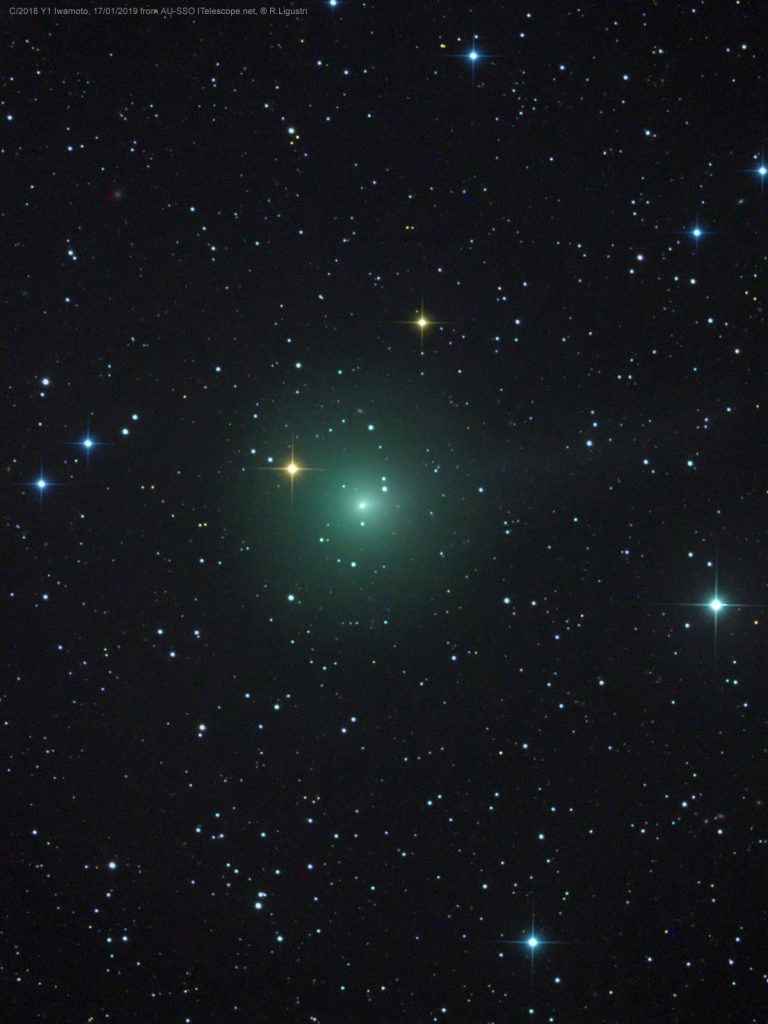Read more about the comet: Speedy comet closest to Earth February 12
View at EarthSky Community Photo. | Comet C/2018 Y1 (Iwamoto), the colorful blue-green dot – captured at its brightest and closest to Earth on the morning of February 12, 2019 – from Indian Fields, Shelburne County, Nova Scotia. Photo by Barry Burgess. Thank you, Barry!
View larger at EarthSky Community Photos. | Joel Weatherly in Edmonton, Alberta, Canada caught this wide view of the comet near the stars Regulus and Algieba in the constellation Leo. He wrote: “I caught a glimpse of comet C/2018 Y1 (Iwamoto) on the evening of February 12, not long after its closest pass by Earth at some 45 million km away. It was a bit chilly out (-32°C), and my camera was struggling with the cold.” Thank you, Joel.
View larger at EarthSky Community Photos. | Comet Iwamoto was heading for the Sickle of Leo – a backwards question mark pattern – when caught by Dr. Ski in the Philippines on the morning of February 11. At closest approach, the comet will be in front of Leo, visible late night to dawn now.
View at EarthSky Community Photos. | Fast-moving comet C/2018 Y1 Iwamoto as captured in 20 50-second images, stacked, by Alan Forsyth in Cowal, Argyll, Scotland. “This fast comet can sure shift through the skies in the 20 minutes of this combined exposure!” he wrote. Photo taken February 10. On Tuesday night, when the comet is closest to Earth at 28 million miles away, its movement will be even more noticeable.
Animated gif showing the motion over 17 frames (approx. 15min of real time) of the fast moving #Comet C/2018 Y1 (#Iwamoto) just down from the constellation Leo on 10-Feb-2019. #Astrophotography #Astronomy pic.twitter.com/lo3vK1HPM0
— Alan G Forsyth Photography (@agforsythphotos) February 13, 2019
View at EarthSky Community Photos. | Comet Iwamoto as captured by Shlomo Shalev from Vancouver Island, Canada, on February 9, 2019.
View larger at EarthSky Community Photos. | Emilio Lepeley in Elqui Valley, Vicuna, Chile caught comet C/2018 Y1 (Iwamoto) – the green fuzzball at bottom center – on February 3, 2019, in the same field of view as the famous Sombrero Galaxy. Thank you, Emilio!

Green comet C/2018 Y1 (Iwamoto) is seen here as it was passing close to the Sombrero galaxy (Messier 104) on February 3, 2019. The galaxy is at the bottom of this image by Rolando Ligustri. Thank you, Rolando.

Comet C/2018 Y1 (Iwamoto) looks great in this image taken on January 17, 2019, by Rolando Ligustri.
from EarthSky http://bit.ly/2GMqPoj
Read more about the comet: Speedy comet closest to Earth February 12
View at EarthSky Community Photo. | Comet C/2018 Y1 (Iwamoto), the colorful blue-green dot – captured at its brightest and closest to Earth on the morning of February 12, 2019 – from Indian Fields, Shelburne County, Nova Scotia. Photo by Barry Burgess. Thank you, Barry!
View larger at EarthSky Community Photos. | Joel Weatherly in Edmonton, Alberta, Canada caught this wide view of the comet near the stars Regulus and Algieba in the constellation Leo. He wrote: “I caught a glimpse of comet C/2018 Y1 (Iwamoto) on the evening of February 12, not long after its closest pass by Earth at some 45 million km away. It was a bit chilly out (-32°C), and my camera was struggling with the cold.” Thank you, Joel.
View larger at EarthSky Community Photos. | Comet Iwamoto was heading for the Sickle of Leo – a backwards question mark pattern – when caught by Dr. Ski in the Philippines on the morning of February 11. At closest approach, the comet will be in front of Leo, visible late night to dawn now.
View at EarthSky Community Photos. | Fast-moving comet C/2018 Y1 Iwamoto as captured in 20 50-second images, stacked, by Alan Forsyth in Cowal, Argyll, Scotland. “This fast comet can sure shift through the skies in the 20 minutes of this combined exposure!” he wrote. Photo taken February 10. On Tuesday night, when the comet is closest to Earth at 28 million miles away, its movement will be even more noticeable.
Animated gif showing the motion over 17 frames (approx. 15min of real time) of the fast moving #Comet C/2018 Y1 (#Iwamoto) just down from the constellation Leo on 10-Feb-2019. #Astrophotography #Astronomy pic.twitter.com/lo3vK1HPM0
— Alan G Forsyth Photography (@agforsythphotos) February 13, 2019
View at EarthSky Community Photos. | Comet Iwamoto as captured by Shlomo Shalev from Vancouver Island, Canada, on February 9, 2019.
View larger at EarthSky Community Photos. | Emilio Lepeley in Elqui Valley, Vicuna, Chile caught comet C/2018 Y1 (Iwamoto) – the green fuzzball at bottom center – on February 3, 2019, in the same field of view as the famous Sombrero Galaxy. Thank you, Emilio!

Green comet C/2018 Y1 (Iwamoto) is seen here as it was passing close to the Sombrero galaxy (Messier 104) on February 3, 2019. The galaxy is at the bottom of this image by Rolando Ligustri. Thank you, Rolando.

Comet C/2018 Y1 (Iwamoto) looks great in this image taken on January 17, 2019, by Rolando Ligustri.
from EarthSky http://bit.ly/2GMqPoj

Aucun commentaire:
Enregistrer un commentaire